This is the 2019 version of our guide to the Best Acoustic Guitar Brands that we began publishing back in 2010. This year we’ve adopted a new format where we present our selection of the Top 10 brands then provide 2 recommendations from each brand.

The acoustic guitar’s basic design remains relatively unchanged, even after many years of technological advances. But this does not stop manufacturers from developing new ways to up the overall quality and appeal of the instrument.
Here we honor the top brands that continue to meet, if not exceed, the expectations of acoustic guitar players, selected based on a combination of our joint 80+ years of experience and the ratings and feedback from people who have bought them, including our insider access to Gearank ratings.
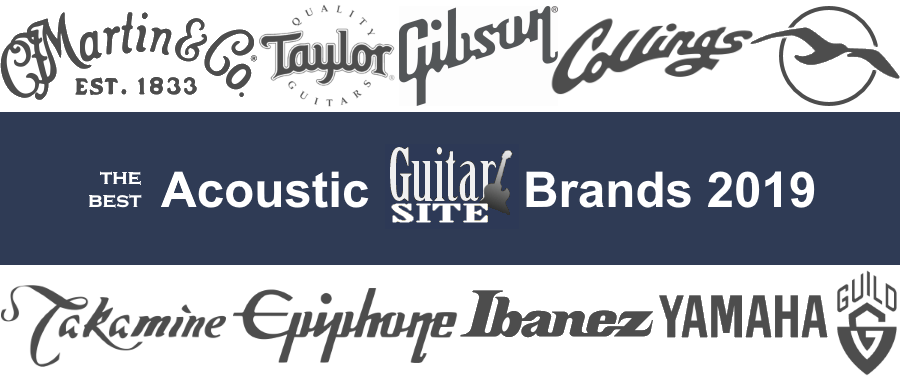
Things to consider when buying an Acoustic Guitar
- Caring For Your New Guitar
The acoustic guitar has a hollow wooden body, which while feels solid to the touch, is a bit fragile, and can be affected by humidity and temperature changes. As such, handling and playing requires extra care, you don’t want to inadvertently scratch or bump your guitar. And it goes without saying that you should be careful not to drop it.
In addition to careful handling, a good guitar case will help prolong the life and maintain the playability of your guitar. It will also make transporting your guitar safer and easier. Humidifiers and Hydrometers are also essential tools to monitor and maintain right humidity for your guitar.
We also recommend getting a good guitar stand so you don’t have to put down your guitar on places where it can potentially be damaged. Having a guitar strap is a given if you’re planning on playing while standing. Finally, you’ll want to regularly clean your acoustic guitar, thankfully there are plenty of cleaning and maintenance kits (Ad link to Sweetwater) available.
- Wood
The use of solid woods on an acoustic guitar is preferred by many because of the improved resonance and sustain they provide. Solid wood, especially when used on guitar tops (the piece on the front that has the sound hole), also ages better in terms of looks and tone. The downside to solid wood is the extra cost, and not to mention it uses more wood resources than laminate.
Solid wood is also more prone to damage, so they require extra care especially from changing weather and humidity. Laminate wood is more affordable, it is also generally sturdy and resistant to weather changes. On the flip side, they will lack the resonance and sustain of solid wood, but this can be a good thing if you’re looking for vintage mid-range focused tone.In addition to choosing between laminate and solid wood, you also have to consider the type of the tonewood. Of particular importance is the choice of top wood, because it greatly affects the resulting sound. Spruce is popularly used for the tops of acoustics because of its punchy and bright tone. Mahogany tops, on the other hand, are preferred for their warm tone, with more emphasis on the lower mid frequencies. There are other types of wood that fall between the two, each one bringing a subtly different flavor to the resulting sound.
- Playability
Playing feel is an important consideration that many seem to neglect. You have to pay close attention to the scale length and nut width and neck profile, to make sure that the neck feels comfortable.
-
- Scale length describes the length that string has to be stretched, basically from the nut to the bridge, or technically twice the distance from the nut to the 12th fret plus compensation for the saddle position. Generally speaking, shorter scale length means softer string tension, making the instrument easier to play. Longer scale length allows for more fret space and more string tension which translates to more sustain. Shorter scale lengths can be good for beginners because the lower tension makes them easier on the fretting fingers when starting out.
-
- Nut width measures how wide the nut is, smaller means easier to play for players with smaller fingers, while wider nut widths allow for more space between each string. Finally, neck profile is the shape or curvature of the back of the neck, and the type of profile you want will depend on your preference, be it vintage style U profile with its fatter neck, or the more modern slim profiles.
-
- Will You Need To Amplify Your Acoustic Guitar?
If you’re a beginner then it’s usually better to get one with pickups already installed which is called an Acoustic-Electric Guitar – see these guides: Acoustic-Electrics from $200 to $500 and Acoustic Electrics Up To $1000. If you would prefer to select and install your own pickups then see our guide to Acoustic Guitar Pickups. Note that most amps designed for electric guitars don’t work very well with acoustic guitars due to unwanted coloring of the tone and a lack of feedback control so you might like to take a look at this guide to Acoustic Guitar Amps.
The Top 10 Acoustic Guitar Brands in Order:
1. Martin
|
|||||||
| Premium |  |
Martin D-28 Authentic 1937 |
A premium reproduction of vintage ’30s era D-28, featuring artificially aged wood that replicates old tonewoods. | Detailed information below | |||
| Popular |  |
Martin D-15M |
A dreadnought guitar with all-solid mahogany body, giving it a different look and warmer tone. | Detailed information below | |||
2. Taylor
|
|||||||
| Premium |  |
Taylor 916ce – Sunburst |
Premium quality acoustic-electric guitar with quality hardware and exquisite cosmetic appointments. | Detailed information below | |||
| Popular |  |
Taylor 214ce Deluxe |
Taylor’s popular acoustic-electric with solid-sitka spruce top at a more accessible price point. | Detailed information below | |||
3. Gibson
|
|||||||
| Premium |  |
Gibson Acoustic SJ-200 |
A flat-top jumbo acoustic guitar crafted from premium AAA grade tonewood, paired with high-end LR Baggs electronics. | Detailed information below | |||
| Popular |  |
Gibson Acoustic L-00 Studio |
A modern reproduction of the popular L-00 “blues box” from the early 1930s. | Detailed information below | |||
4. Collings
|
|||||||
| Premium | 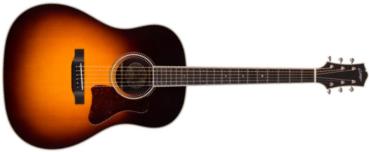 |
Collings CJ |
Bill Colliings himself designed this guitar’s body shape, which is a hybrid of the dreadnought and jumbo. | Detailed information below | |||
| Popular |  |
Collings OM1 |
This is the company’s take on the venerable OM body guitar, with Collings’ brand of attention to detail and build quality. | Detailed information below | |||
5. Seagull
|
|||||||
| Premium |  |
Seagull Maritime SWS CH CW QIT |
An all solid wood acoustic-electric guitar with Seagull’s quality and distinct design. | Detailed information below | |||
| Popular |  |
Seagull S6 Cedar Original |
This affordable solid cedar top guitar bears the same quality as other Seagull acoustics at a more accessible price point. | Detailed information below | |||
6. Takamine
|
|||||||
| Premium |  |
Takamine EF341SC |
All solidwood dreadnought acoustic-electric with Takamine’s top-of-the-line CT4B II preamp. | Detailed information below | |||
| Popular |  |
Takamine GD20-NS |
Affordable dreadnought acoustic with solid cedar top and Takamine’s split saddle bridge. | Detailed information below | |||
7. Epiphone
|
|||||||
| Premium |  |
Epiphone Masterbilt DR-500MCE |
An all solid wood dreadnought with bridge and neck pickups and a stereo preamp system. | Detailed information below | |||
| Popular |  |
Epiphone Hummingbird Pro |
An affordable version of the classic Hummingbird from Gibson, complete with a solid sitka spruce top and ornate appointments. | Detailed information below | |||
8. Yamaha
|
|||||||
| Premium |  |
Yamaha LL16D ARE Original Jumbo |
All-solid jumbo body acoustic guitar that applies Yamaha’s artificial aging process, non-scalloped bracing and neck design. | Detailed information below | |||
| Popular |  |
Yamaha FG830 Dreadnought |
This affordable solid-top acoustic guitar is selling like hot cakes worldover, and for good reason. | Detailed information below | |||
9. Ibanez
|
|||||||
| Premium |  |
Ibanez
|
Part of Ibanez’ flagship line of acoustics, the AE255BT is a baritone acoustic-electric guitar with solid sitka spruce top and ovangkol back and sides. | Detailed information below | |||
| Popular |  |
Ibanez AW54CE – Open Pore Natural |
An affordable acoustic-electric with solid okoume top, with open pore natural finish. | Detailed information below | |||
10. Guild
|
|||||||
| Premium |  |
Guild D-55 – Natural |
A premium handcrafted rendition of the classic Guild D-55 using high-grade tonewood. | Detailed information below | |||
| Popular |  |
Guild OM-120 – Natural |
An all-solid mahogany body acoustic guitar with a slightly smaller OM body that pays tribute to their ’60s era designs. | Detailed information below | |||
Detailed information about the guitars we recommended above for each of the Top 10 Acoustic Guitar Brands
Martin D-28 Authentic 1937
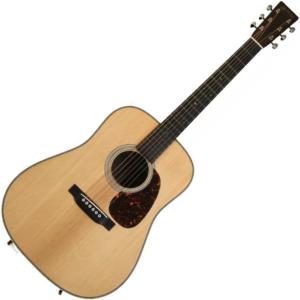
There will always be demand for vintage Martin guitars, some more than others, like 1937-built D-28s which are highly valued for their looks and tone. But since good condition vintage Martin guitars are rare, and not to mention expensive, the company decided to make modern reproductions with artificially aged wood. Martin accomplishes this via their Vintage Tone System (VTS) process, which applies controlled heat on wood to mimic the properties of old wood without having to wait for decades.
In particular, the Martin D-28 Authentic 1937 is modeled after its vintage counterpart, employing premium tonewood (solid Adirondack spruce top and solid Madagascar rosewood for the back and sides), and utilizing old school methods. It follows after classic dreadnought specs, featuring handcrafted forward shifted x-bracing.
Soundwise, the Martin D-28 Authentic 1937 gets a lot of praise from users, some even going so far as saying that it is the apex of dreadnought guitars. Obviously the price tag is quite steep, but it is a necessary price to pay if you want a premium quality, US handcrafted acoustic guitar.
If you want nothing less than the best dreadnought, the Martin D-28 Authentic 1937 is a worthy investment.
Hear and see the Martin D-28 Authentic 1937 in action below:
Martin D-15M
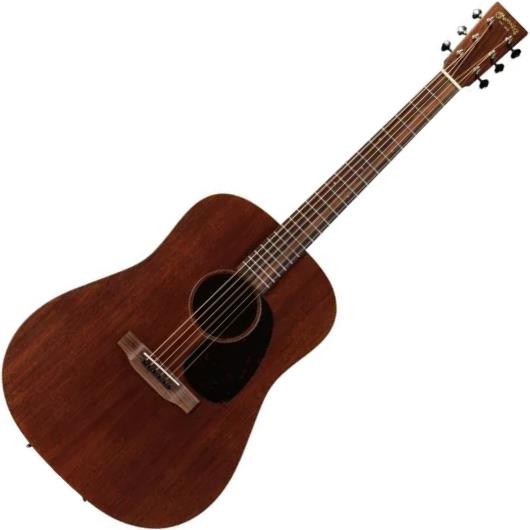
First introduced in the 1940’s, the D-15M continues to be an important part of Martin’s lineup, it’s standout feature being its all mahogany body, which gives it a warmer, fuller tone. While cosmetically streamlined, Martin did not skimp on specs and build quality, equipping this guitar with an all-solid mahogany body, crafted in their US-based facility. Because of its warmer tone, picking attack and articulation are emphasized better, complementing the treble focused sound of spruce top equipped acoustics.
Aside from the use of mahogany, this guitar follows after conventional dreadnought specs, including its scale length of 25.4″, and nut width of 1.6875. It also features a Modified Low Oval neck with satin finish that results in playability that many appreciate.
The Martin D-15M continues to get rave reviews from users and pros who are impressed with its tone, described with a myriad of adjectives like rich, full , warm, organic and many more. More importantly, it does all this while keeping the distinctly “woody” tone expected from Martin guitars. There are also plenty of thumbs up for its build quality, although there are a few who caution that big changes in humidity and temperature may cause some issues.
The Martin D-15M is highly recommended for those who are looking for a premium quality all-mahogany acoustic, it is also ideal if you’re looking for a reasonably priced accompaniment acoustic guitar that’s built by a premium brand.
See the video below to have a closer look at the Martin D-15M:
Taylor 916ce
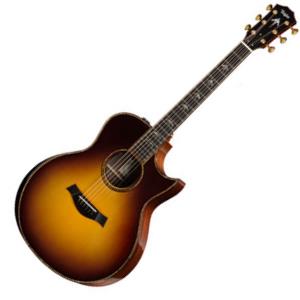
The 916ce is a true centerpiece for Taylor, showcasing their brand of attention to detail and tone. It has a Grand Symphony body, which is around the size of a jumbo body, with a slightly wider lower bout that helps emphasizes the lows and mids. Premium grade tonewoods are used, including solid AA spruce for the top and solid AA Indian rosewood for the back and sides.
Giving this guitar its amplified voice is Taylor’s ES2 (Expression System 2) electronics, with a 3-section proprietary pickup positioned behind the guitar’s saddle. Controls are streamlined and designed to be discrete, with just three knobs that let you adjust volume and tone, it also has a phase switch that can be useful for managing feedback. Finally, the Taylor 916ce comes packed with exquisite inlays, trims and an armrest that ups its overall cosmetic appeal and makes playing more comfortable.
While Taylor guitars are known to sound bright and clear, the 916ce’s subtle boost on the bottom end gives it a fuller sound. You don’t need to buy a top-of-the-line Taylor guitar to appreciate their brand of modern playability, so that’s a given, but the 916ce’s armrest adds even more to it.
This guitar requires serious investment, but it won’t be much of a hindrance for those with a passion for premium quality tone and playability.
See and hear the Taylor 916ce in action:
Taylor 214ce Deluxe
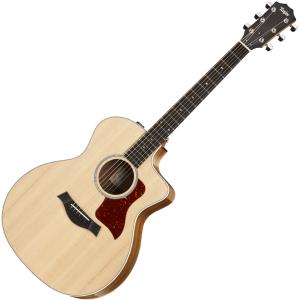
While the Taylor 214ce Deluxe is not the cheapest in Taylor’s line of guitars, many consider it as a great entryway into premium acoustic guitars. It sports a Grand Auditorium body style, which is similar to a dreadnought, but with a cutaway and a narrower waist, which helps better emphasize the highs.
Tonewood used is pretty much standard, with a solid sitka spruce supported by a forward-shifted X-bracing, and layered rosewood for the back and sides. But what separates it from other guitars is Taylor’s attention to detail and consistent build quality. For plugging in, Taylor equipped this guitar with the Expression System 2, a pickup co-designed by Rupert Neve, which features three pickup sensors situated behind the saddle.
Other features include easier acess to the upper frets via the Graceful Venetian cutaway that gives you free access to upper frets, sapele neck with ebony fingerboard and it ships with a Taylor hardcase.
The 214ce Deluxe is a no brainer for Taylor fans, even those who want a reasonably priced guitar from Taylor will appreciate the 214ce.
Gibson Acoustic SJ-200 Standard
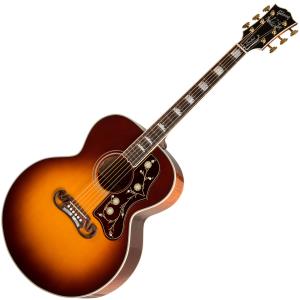
The Gibson SJ-200 Standard is dubbed as the “King of Flat Tops”, a modern reproduction of Gibson’s top-of-the-line Super Jumbo acoustic guitar from the 1930s. Since good condition vintage specimens of the SJ-200 are very rare, this gives guitarists of today the ability to own one without having to spend their life savings. It’s distinctive feature is its “super jumbo” body, which is bigger than average, resulting in improved projection that was needed back in the ’30s, when amps and pickups were not yet available.
Given the price tag, it’s only fair to expect premium specifications, and that is exactly what you get with its AAA-grade solid sitka spruce top, and flame maple back and sides. They also updated its classic design by adding modern electronics – the LR Baggs Anthem hybrid pickup which blends the sound of an undersaddle pickup and a mic, both of which are situated discretely on the guitar. It also comes with opulent inlays on the pickguard, bridge, headstock and fingerboard.
When it comes to acoustic projection and extended bass frequencies, size does matter. The Gibson SJ-200 easily stands out from conventional acoustics with its size and volume. It continues to impress users with its attention to detail and overall craftsmanship. Note that its bulky body may seem uncomfortable at first, and may take some time to get used to.
If you look at it from a collector’s perspective, the Gibson SJ-200 Standard is quite the deal given its overall quality and the addition of modern electronics and hardware.
Watch the video of the Gibson SJ-200 in action below:
Gibson L-00 Studio
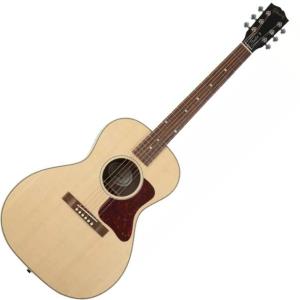
The Gibson L-00 Studio is a great example of enduring design, still in demand long after the first L-00 was released by the company in the early ’30s. It’s smaller profile makes it easy to distinguish from regular acoustics, but what truly sets it apart is the slight mid-range bump that’s expected of small body acoustic guitars.
Don’t mistake the Gibson L-00 Studio to be just another parlor guitar on the market, because this one bears the label Gibson, along with all the attention to detail, quality craftsmanship and premium hardware that you’d come to expect from the brand. It sports a premium solid sitka top, supported by hand-scalloped X-bracing, along with walnut back and sides.
For a smaller guitar, the Gibson L-00 Studio actually plays much like a regular acoustic with its traditional neck specifications. This includes having a scale length of 24.75″, a nutwidth of 1.725″. To help this classic design cross over into the modern era, Gibson employed Grover Mini Rotomatic machine heads, Graph Tech Tusq nut, and LR Baggs VTC pickup system.
If you’re looking for a serious parlor guitar to play with on your living room or on stage, then check out the Gibson L-00 Studio.
Collings CJ
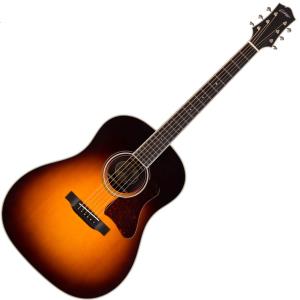
“CJ” is short for Collings Jumbo, which is the company’s version of the classic slope-shoulder dreadnought/jumbo hybrid. It doesn’t stray too far from dreadnought specs, but has a subtly different tone thanks to its wider bottom bout. The default configuration utilizes Sitka spruce for the top, partnered with Indian rosewood for the back and sides, all of which are pieced together with utmost care in terms of build and material quality.
What makes the Colling CJ even more special is the ability to make adjustments to its design. You can change the top to solid mahogany or koa, and there’s even an option for using torrefied versions of popular tonewoods. Mahogany, wenge, walnut, maple and koa are the tonewood options for the back and sides. You can also personalize its cosmetics by dictating the type of finish, binding and inlays.
There are also plenty of neck customization options that allow you to tailor fit the guitar’s playability to your liking. Collings even noted that shortening the scale length results in a more controlled bottom end, ideal for blues.
With its old-school appeal, solid build quality, and customization options, it’s hard to find any fault with the CJ.
Collings OM1
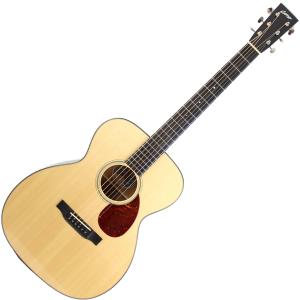
This is Collings take on the iconic “Orchestra Model”, carrying over its basic shape and profile with the company’s brand of quality. It offers a nice visual and sonic contrast to bigger models like the CJ and other dreadnought style guitars. Its thinner body makes it comfortable to play, while the less boomy tone is ideal for fingerpickers.
Its base configuration shows a solid sitka spruce top and honduran mahogany back and sides, with a 25.5″ scale length and 1 11/16″ nut width. But none of these features are set in stone, because you can customize the guitar to your liking with a long list of tonewood options, hardware and neck specifications. You can also change its overall look – from the finish, to the pickguard, to the bindings. Which means that you are getting a one-of-a-kind instrument as you specified, much like a boutique guitar.
To ensure the quality of their guitars, much of the work done on the guitar is by hand. This also means that the price tag will not be anywhere near that of mass produced guitars. Still, many are willing to pay the premium to ensure that they are getting a high-quality instrument. Some even go so far as saying that Collings have surpassed the quality of more established brands.
The Collings OM1 is not just another generic OM guitar, rather it is a meticulously handcrafted and personalized instrument for those who can make the investment.
Here is the official video demo of the Collings OM1 base configuration:
Seagull Maritime SWS CH CW QIT
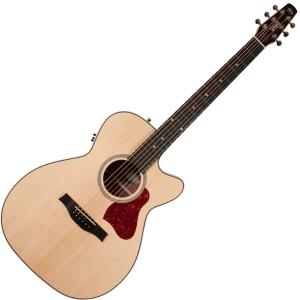
For an all solid acoustic guitar that’s crafted in North America, the Seagull Maritime SWS CH CW QIT is quite the deal. The solid spruce used on its top is pressure tested, a feature that’s common for most if not all Seagull guitars. This special top is paired with solid mahogany for the back and sides. The body of this guitar follows a smaller and lighter concert hall profile with cut-away and built-in electronics.
Speaking of electronics, Seagull equipped this guitar with QIT electronics that utilize an under-saddle pickup, which in turn drives its preamp/EQ system. It comes with all the features that make Seagull unique, including the tapered headstock that aligns the tuner with the nut for improved intonation, the arched top and the integrated set neck.
While Seagull is not necessarily a household name, more and more guitarists are singing its praises. And it’s mostly about build quality, which also translates to improved playability and tone. And it also helps that you’re getting premium quality all-solid tonewoods at a bargain price. While it’s not fair to expect big punchy tone from its smaller profile, it sounds better than what most expected of it, and this is reflected in its consistently high ratings
With its solid quality and value for money, it’s hard to go wrong with the Seagull Maritime SWS CH CW QIT.
Here’s the official video demo of the Seagull Maritime SWS CW QIT:
Seagull S6 Cedar Original
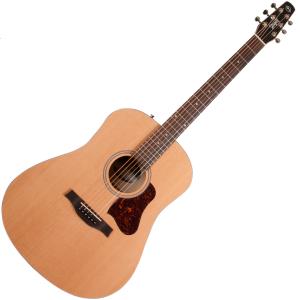
This guitar nicely represents what Godin is all about, a carefully crafted instrument with a very generous price. Its main feature is its solid cedar top which passed Godin’s pressure testing process. Cedar is commonly used on nylon string guitars, but Seagull was able to incorporate it into their steel-string acoustic guitar designs, and be quite successful at that. Aside from looking different, cedar is known for a warm tone that sits between spruce and mahogany.
Another distinct feature of the S6, is the use of locally grown Wild Cherry wood, which gives the guitar a different appearance and slightly adds brightness to the resulting tone. The neck is crafted from silver leaf maple, and is integrated into the body via Godin’s own set neck design. It also features a narrower nutwidth of 1.8″ that makes it easier to play with for those with smaller hands.
Other distinctly Seagull features include its tapered headstock for aligning the strings, tuners and the nut and the slightly arched top design. With its dreadnought inspired body, many are impressed at how full sounding the S6 is. Most users are also in awe of how good the guitar feels in your hands, a testament to Godin’s consistency.
There’s a reason why the Seagull S6 Cedar Original continues to be among their top sellers, do check it out.
Check out the official video demo of the Seagull S6 Cedar Original:
Takamine EF341SC
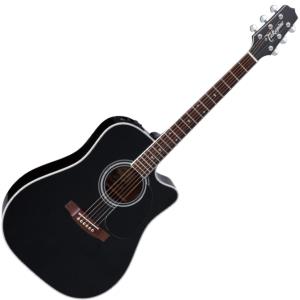
Aside from its nice looking black finish, there’s nothing visually fancy about the EF341SC. But don’t count it out yet because instead of going for bells and whistles, this one follows familiar specs, the main difference being its handbuilt quality, the use of non-conventional tonewoods, and top-of-the-line electronics.
While its shape is familiar, this guitar is not your average dreadnought. First off it has a solid cedar top instead of the usual spruce, giving it a warmer tonality. Another key difference is the use of maple for the back and sides, a type of wood known for adding subtle brightness to the resulting tone. And as expected from a Takamine guitar, it comes with a feature packed preamp and pickup system, with slider type EQ controls and chromatic tuner.
Many users are drawn to this guitar by its black finish and impeccable craftsmanship. But the admiration is not just skin deep because even those with more expensive acoustics are impressed with its tone. To most reviewers, this guitar has a more balanced and clear sounding acoustic tone, contrasting the usual boomy low-end expected of conventional dreadnoughts. While some are put off by its price tag, most of those who tried this guitar have mostly good words to say, special mention also goes to the responsiveness of its slider EQs. Many also appreciate being able to easily see their EQ settings at a glance.
With its distinct tone and sleek black finish, the Takamine EF341SC is definitely a fine instrument worthy of your consideration.
Jake Allen puts the Takamine EF341SC to work in this demo video:
Takamine GD20-NS
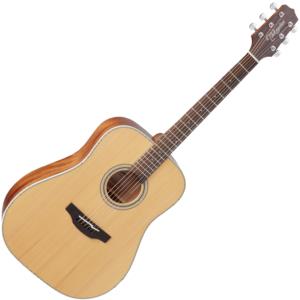
The Takamine GD20 is a budget-friendly solid-top dreadnought acoustic. It doesn’t come with built-in electronics, but it more than makes up with its solid cedar top, which for the price is still quite a deal. The top is supported by a quartersawn x-bracing, along with mahogany back and sides that form its familiar dreadnought shape.
Don’t write it off as just another affordable dreadnought clone, because the GD20’s solid cedar top gives it a more balanced tone which will only get better as the wood ages. Neck specifications suggest a familiar playing feel with a nut width of 1.6875″, a fretboard radius of 12″ and a scale length of 25.3″
Playability is the Takamine GD20-NS’ strong suit, and it’ not because they did anything unique, rather they followed after familiar specs but do so properly. Even experienced users who have owned more expensive guitars are floored by its string action and overall setup. The guitar’s tone is also well-loved, versatile enough to handle heavy strumming and expressive plucking. The only downside for me is its bland look, but it’s not even that bad looking either, just a little too basic.
The Takamine GD20-NS’ is a great value dreadnought acoustic that’s ideal for those working with budget constraints.
Check the video below to appreciate the Takamine GD20-NS some more.
Epiphone Masterbilt DR-500MCE
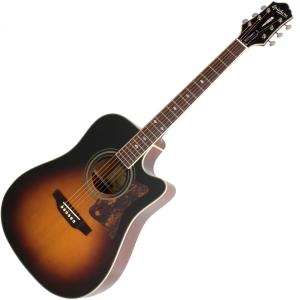
For the price of a mid-tier acoustic, the Epiphone Masterbilt DR-500MCE comes with an all-solid wood body, a feature that’s usually only available from those that are priced much higher. If that’s not enough, it also comes packed with electronics with features that you won’t expect in its price range.
The DR-500MCE is Epipone’s premiere dreadnought, with a solid sitka spruce on top, and solid mahogany for the back and sides. It also has a cut-away for easier upper fret access. The guitar’s one-piece mahogany neck is glued into the body via dove-tail. It has a 14″ radius rosewood fretboard, with a scale length of 25.5″ and a nut width of 1.68″. Other components include Grover Sta-Tite 18:1 machine heads, bone nut/saddle and rosewood bridge.
Adding more to its already impressive specs is the Shadow NanoMag neck pickup and Shadow NanoFlex bridge pickup, both of which are wired to the eSonic-2 Stereo preamp. It gives you stereo output, separate EQ control for the two pickups, a master volume, a phase switch and a tuner. When it comes to value for money, the DR-500MCE is simply hard to beat, and it also helps that many are impressed with its overall performance, from its build quality to its acoustic and amplified tone.
The specs speak for itself, the Epiphone Masterbilt DR-500MCE is definitely a steal.
The video below talks about the electronics in a bit more detail:
Epiphone Hummingbird Pro
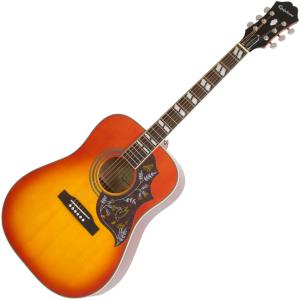
If you’re wondering why the Hummingbird guitar looks familiar, it’s because of a long list of artists users which include Keith Richards, Brian Jones, Chris Cornell, John McLaughlin, Brian May, and many more. The Epiphone Hummingbird makes this iconic guitar more accessible to the masses, carrying over the same design as its more expensive Gibson counterpart.
Epiphone’s version comes with a solid Sitka spruce top and laminate mahogany for the back and sides, all of which form its square shoulder dreadnought shape. What makes the Hummingbird different from other Epiphone acoustics in this price range is its ornate appointments, which include the instantly recognizable hummingbird pickguard, distinct faded cherry sunburst finish and split parallelogram inlays. The guitar is also stage-ready with its built-in Shadow ePerformer preamp.
It’s no secret that most are first attracted to its distinct yet familiar look, and rightly so with all the effort from Epiphone to make the Hummingbird pleasing to the eye.
But it doesn’t end there because it has the specs, build quality and sound to back up its good looks. It is simply a fun instrument to have, and I would be especially envious of beginners who will have the honor of having this as their first acoustic guitar.
For the money, the Epiphone Hummingbird Pro gives you quite a lot – from its iconic look to its nice specs and tone.
Acoustic Guitar Magazine have mostly good things to say about the Hummingbird Pro – check out their review below:
Yamaha LL16D ARE Original Jumbo
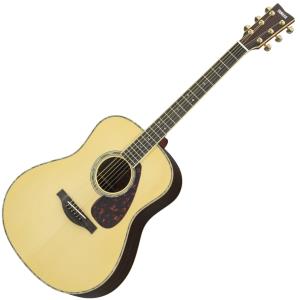
In response to the growing interest in artificially aging wood for use in guitars, Yamaha developed their own method called A.R.E. short for Acoustic Resonance Enhancement. This process entails applying temperature, atmospheric pressure, and humidity to manipulate wood, in order to mimic the molecular properties of old wood.
This process is used on the Yamaha LL16D ARE’s solid Engelmann spruce top and solid rosewood back and sides, to mimic the look, feel and sound of vintage instruments.
This guitar also utilizes a non-scalloped bracing and a 5-ply mahogany neck structure that Yamaha developed to improve tone, playability and structural stability. On top of all that, the company did not hold back on aesthetics, adding intricate abalone inlays on the rosette and the body. Interestingly, this guitar comes equipped with a passive SRT Zero Impact pickup, instead of the usual active pickup+preamp setup. Instead of having a single piezo pickup running across the bridge, the SRT Zero Impact has dedicated piezo elements for each string, resulting in improved definition and clarity.
The first thing that catches attention is its overall craftsmanship. Those who tried this guitar are floored by how good the build is, down to the littlest details. Thanks to its ARE treatment, the guitar’s resonance is very noticeable, so much so that some even compare it to more expensive guitars from big-name competitors or to actual vintage acoustics. There are some concerns about the lack of built-in preamp, but bypassing the preamp actually gives guitarists more control over the tone by employing their preamp pedal of choice.
Yamaha went all out with the LL16D ARE and the result is an instrument that looks as good as it sounds.
Hear the Yamaha LL16D ARE in action, alongside its L-Series siblings:
Yamaha FG830
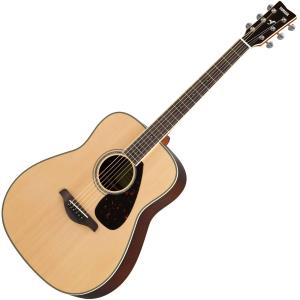
There’s a good reason why the Yamaha FG series continues to sell well, and its mostly thanks to Yamaha’s reputation for student-friendly quality and value for money. In particular, the FG830 is doing well with its solid sitka spruce top and laminate rosewood back and sides that form its familiar dreadnought shape and tone. Note that Yamaha tweaked the waist a tad bit to make the dreadnought body more comfortable, especially for smaller players. It also happens to look a bit better with its tapered waist.
The neck is designed to be as comfortable as possible, with a slim tapered profile and satin finish. It is topped by a rosewood fingerboard that follows after traditional specs, with a 25.5″ scale length and 1.6875″ nut width.
For the money, the Yamaha FG830 is simply an impressive deal, even more so to students and beginners, for whom this guitar is being marketed for. But what’s even more impressive is how the FG830 wows experienced players, myself included, with its build quality and playability. Some might consider this guitar to be a little too plain-jane, but that is precisely what the FG series is all about, staying within convention while keeping the quality up and the price accessible.
The Yamaha FG830 is the student guitar to beat, highly recommended for those who are starting out.
Here’s a less talk more music video demo of the FG830:
Ibanez AE255BT
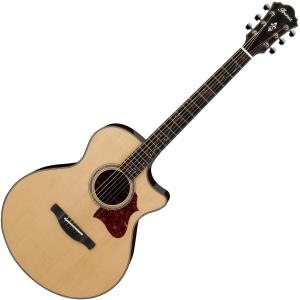
Being a baritone guitar, the Ibanez AE255BT is a unique entry in this list. It’s long 27″ scale length neck is meant to handle alternate/low pitch tunings that would otherwise sound buzzy on regular acoustics. And since alternate/drop tunings are usually associated with modern music, Ibanez is the perfect fit to make a guitar that’s just right for the job.
And getting the job done is exactly what this guitar does, with its lower pitch complemented by its AE body. This Ibanez’ designed body shape has a rounder lower bout and tighter waste that give it a sleek vibe, and helps balance out the lows. The top is crafted from solid sitka spruce and supported by ovangkol back and sides that ups the mids and highs for a more balanced overall sound.
While baritone guitars are not everyone’s cup of tea, those who are looking to take advantage of low tuning will appreciate the AE255BT quality. This guitar has seen good use as a songwriting tool, for those who want to break free from conventional tuning. But it is also a great accompaniment tool, either as standalone or when playing along with a group. As expected from an Ibanez made guitar, playability is its best trait, seconded by its value for money.
If you’re looking for a great quality baritone guitar, or if you’re just tired of standard tuning and want to try drop/low tunings, then this is highly recommended.
Here’s Ibanez official video demo of the Ibanez AE255BT:
Ibanez AW54CE – Open Pore Natural
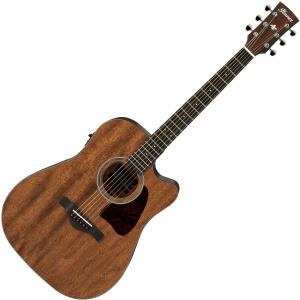
Since Okoume is from a fast-growing tree, it can be more environmentally sustainable and affordable. As such, it is a good alternative wood for use on budget-friendly guitars. The Ibanez AW54CE takes advantage of this renewable resource, with a solid okoume top and laminate okoume back and sides. Okoume has similar properties to maple, being lightweight yet with vibrant colors and grains, which results in a brighter tone for the AW54CE and an earthy rustic appearance.
Thankfully, the guitar’s dreadnought cutaway shape adds a bit more bottom-end to balance out the resulting sound. Coming from Ibanez, playability is expected to be smooth, with a fingerboard radius of 15.7″, nut width of 1.69″ and a scale length of 25.62″. Wrapping up the features of this guitar is the Ibanez AEQ210TF preamp with tuner, which is paired with a Fishman Sonicore Pickup, a popular piezo pickup used on many of the guitars in this price range.
While I’d rate it highly for its looks, its playability gets the most mentions in reviews. And this is to be expected, given Ibanez’ penchant for making flat fingerboards and neck profiles that are easy to play. Note that the width is a wee bit wider, and the scale is a bit longer than usual. Experienced players are not easily impressed with its tone, but students and beginners are more than happy with how it sounds.
If you’re looking for a cool looking acoustic-electric guitar that’s easy on the hands and on your pocket, then check out the Ibanez AW54CE.
Here’s a video demo that showcases its unplugged acoustic tone:
Guild D-55
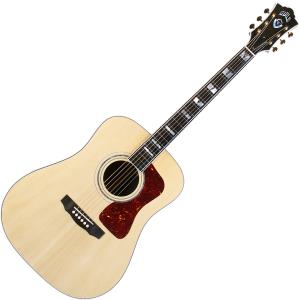
The Guild D-55 is a modern reproduction of the original D-55, a top-of-the-line model back in the late ’60s and early ’70s – which up to this day is revered for its tone. This new version stays true to the original in terms of tonewood, sporting AAA grade solid spruce for the top, and solid rosewood for the back and sides – all of which form its traditional dreadnought shape.
Its mahogany/walnut/mahogany neck joins the body via a dovetail joint with appointments like an ebony headcap and a slim heel profile. It is topped by an ebony fingerboard with mother-of-pearl and abalone position inlays, following traditional specs that include 1.6875″ nut width, and a 25.625″ scale length. Other features include ebony bridge, abalone rosette, Gotoh 700 Series gold-plated open-back tuners, and a tortoiseshell pickguard.
Magical and heavenly may not be very clear adjectives to describe tone, but that is how some users describe D-55’s sound. It impresses even the most experienced players, many of whom share their satisfaction in having a D-55 added to their collection. It is also just as striking visually, to the point that even those who owned the original Guild D-55 from the ’70s are impressed. Looking at the market’s general sentiment, Guild – under Cordoba – did the right thing in bringing this gem of a guitar back in production.
Fans of classic Guild guitars will rejoice over this guitar, but for those who are not, this one is sure to nudge their list of favorites.
The reviewer in the video seems just as impressed at the Guild D-55 as most of us are:
Guild OM-120
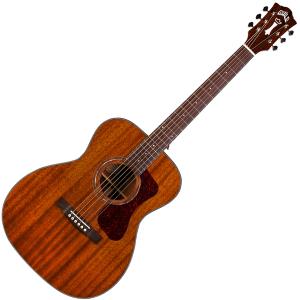
The Guild OM-120 sports an Orchestra Model (OM) body built using solid mahogany for the top, back and sides. This combination of a compact body profile and solid mahogany results in a warm tone with excellent sustain and complex harmonics. Not to mention that OMs are generally more comfortable to play with, and easier to lug around.
The guitar’s mahogany neck has a vintage C-shape profile, and topped by a 20-fret 25.5″ scale Indian rosewood fretboard. Since the warm tone of OM shape guitars are more conducive to fingerstyle playing, they are often paired with a wider fretboard, which is also the case with the OM-120, which sports a 1.75″ wide nut and 16″ fingerboard radius. Finally, the headstock shape, inlays and the pickguard are all reminiscent of Guild guitars released in the ’60s.
I for one have owned, and still own solid spruce topped guitars, but there is something about mahogany topped ones that make me gravitate towards them more, especially when I’m playing intimate venues or on my own. And for this same reason, many are simply blown away by the sound of this guitar. There is also plenty of good feedback about its playability, but there are a few who feel that the neck is a tad bit wider than they expected. And while this model does not come with pickups, there are some users who have gotten great results after adding in LR Baggs pickups.
If you don’t have a mahogany top acoustic yet, you’re missing out big time. The Guild OM-120 is a great place to start looking!
Below is the official short but sweet video demo of the Guild OM-120:

Thank you to Sweetwater for their sponsorship and providing the full specifications for the guitars above where possible. You can see more acoustic guitars at www.sweetwater.com/shop/guitars/acoustic/
You can tell the world which acoustic guitar brands you feel should be on this list in the comments section below.
If you’re looking for an acoustic guitar that can handle low frequencies, then check out our best acoustic bass guitar recommendations.
One last tip: If you’re going to be doing some recording with an acoustic, you should check out this gear guide: The Best Microphones for Recording Acoustic Guitar and while you’re at Gearank.com you can check out how the Gearank Algorithm ranked The Best Acoustic Guitars.
Related Items:

If you’re looking for acoustics in the sub $1000 price range, then take a look at our further recommendations here.

The 5 Best Acoustic-Electric Guitars Under $500.

Here is what we rate as the best acoustics available for under $300.

Here are the best cheap acoustic guitars in the $100 to $200 range.

Check out this collection of electric brands which our team here are GuitarSite.com have rated as the best.

And here are further roundups of some important acoustic guitar accessories & addons: Cases – Guitar Straps – Tuners – Acoustic Pickups – Acoustic Guitar Amplifiers



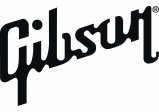







If you haven’t tried a higher end Yairi then you have missed it. These are great hand crafted guitars with a very good neck and great sound. They are branded Alverez in the US but be sure it is one of the Yairi made. There are not lots of them made due the the complete hand crafted design. You don’t find them in the music stores much but they should be there. I have owned one for many years and have yet to pick up any other guitar that can match it in my opinion
I agree I have a yari signature series and before I bought it I tried 4 or 5 Martins and still prefered the Yari
I think gibson guitar brand is the best, his voice clear as Epiphone DR-100, but now I still do not have money to buy it.
i want to start my guitar lessons from next month onwards so i want to buy new acoustic guitar so whts the best beginner guitar below $100
Dont buy too cheap. The cheaper the guitar, the harder to play and the less quality the sound. You want a rewarding feel and sound or you will get discouraged. Buy a better guitar used than a new one cheap. Are you going to learn chords or fingerpicking ? Some guitars are better sounding for one than the other. Some like Taylors are versatile and provide good sound for both. Be smart. Good luck.
The best new acoustic guitar in that price range is the Epiphone DR-100 at the top of the list above.
TM has a good point – you could get a better one second hand – but there are many pitfalls when you don’t know what to look out for in a second hand guitar.
The truth is that right now you have no way of knowing what you’ll want in the long run, and any guitar you buy now with your budget is going to be one you outgrow in a year or so.
My opinion is that you should go with a brand new Epiphone DR-100 for now, and then once you understand the instrument better you’ll be in a much better position to decide what you really want in the long term, and in a much better position to understand what you’re getting when you buy second hand.
An acoustic guitar for under $100 is like buying a car for $300. Is there an engine in it? Probably not.
The lowest I’d tell you to go is $200. Seek out the WD10S from Washburn. It ranks in the top 5 for guitars in that price range on any list you’ll find. It has a solid spruce top and is actually a good little guitar. You may be able to find a used one in about the $100 – $150 price range. Good luck!
TM
Thank you for listing of Guitar..I am very interested like this musical instruments..
Wow,,Its amazing.!!It helps to the buyers who are really interested in bands and musics.
For the money, it is just hard to beat the CD-60 Dreadnaught. It is easier to learn on and for people like me, with small hands, it is just easier to play. Doesn’t have the sound quality of some high enders, but, for the money, good guitar.
no lakewoods here?? really??? are they that crappy about guitars??? i thought they were one of the best. . .
After reading all these reviews there is one important thing missing. Guilds are not on the list. I own a guild d55 and a GAD 50E and a couple gibsons and my guilds beat em hands down for sound, feel, price and quality. PRS make some smokin acoustics to, but you would need to sell your organs to pay for one.
Cheers
Guilds is in fact one of the good acoustic guitar amongst the many branded brand.
You make a good point about Guilds – they are deserving, and when we update this list they will stand a strong chance of being included.
However, I wouldn’t sell a Hammond to buy a PRS – maybe an old Casio though 🙂
That Gibson SJ-250 Monarch… nice looking box –
But will it sound better than my fifty year old, beaten up old Yamaha FG140?
Frankly I’m really not impressed by anything made by Gibson, and their prices are
ridiculous.
As for Taylors.
Nice looking boxes, but overpriced, pretentious crap.
Not even very well made, I played one recently with some of the roughest fret edges I’d ever seen.
Man , I never heard a guy badmouth Gibson and Taylor in the same sitting. I ve owned a Taylor 314 and 814. Both are beautifully made and easier to play than Gibson or Martin. No fret drag at all. If you can only own one guitar, get one thats versatile like a Taylor 314. It strums and fingerpicks brightly. Not thumpy like some others.
Maybe it should be renamed best american acoustic guitar? I don’t see 1 spanish guitar there. or perhaps ramirez or rodriquez guitars don’t compare?
You make a good point – but this page was only intended to be about steel string guitars.
There are guitars on this page from outside America, so I guess you’re referring to nylon stringed guitars.
I’ll put a special page for nylon string guitars (which I play myself) on the list of things to do – but it will take a while because there’s a lot of research that goes into producing a special page like this.
Washburns D46S should have made the cut. I’ve never had a better guitar ever! The ash back and sides compliments the rich tone produced by the spruce top and the action is beautiful. It cost me $329 when I bought it. Mine is left handed and very few stores will sell the leftys.
So what kind of wood is suitable for production of the guitar it? And what kind of wood in turn impact on the sound. For readers, how to select a sound of guitar or bass for their own is also an important issue. We now choose to discuss some common materials.
I produce dreadnought and dreadnought cutaways with sitka spruce tops and a choice of mahogany or East Indian Rosewood back and sides.
The mahogany produces a loud but mellow sound. The rosewood being a harder denser wood produces a sharper sound… it is not as mellow as the mahogany but still able to project the sound very loudly.
Anther thing that greatly effect the sound quality and allow for the projection of sound is the bracing. I always use the scalloped bracing. Removing a little wood from the bracing in the scalloped design allows the sound board to vibrate more producing a larger volume of sound.
http://www.rmolsonguitars.com
Guitars and guitar kits including a replica
of the Languedoc style Guitar
Takamine 2010 Limited Edition Dreadnought should have been in the list
great collection! 🙂
Haha, I was like, wait why is there only one Taylor so far when I read the intermediate section. You’re right, there are just too many Taylors…haha…
Taylor s are soo sweet if you play at all you would understand